Wing interference patterns are consistent and sexually dimorphic in the four families of crane flies (Diptera, Tipuloidea)
- PMID: 35068968
- PMCID: PMC8755705
- DOI: 10.3897/zookeys.1080.69060
Wing interference patterns are consistent and sexually dimorphic in the four families of crane flies (Diptera, Tipuloidea)
Abstract
Wing interference patterns (WIP) are stable structural colors in insect wings caused by thin-film interference. This study seeks to establish WIP as a stable, sexually dimorphic, species-level character across the four families of Tipuloidea and investigate generic level WIP. Thirteen species of Tipuloidea were selected from museum specimens in the Academy of Natural Sciences of Drexel University collection. One wing from a male and female of each representative species was excised and mounted to a slide with coverslip, placed against a black background, and imaged using an integrated microscope camera. Images were minimally retouched but otherwise unchanged. Descriptions of the WIP for each sex of each species are provided. Twelve of thirteen species imaged had WIP, which were stable and species specific while eight of those twelve had sexually dimorphic WIP. Comparisons of three species of Nephrotoma were inconclusive regarding a generic level WIP. Gnophomyiatristissima had higher intraspecific variation than other species examined. This study confirms stable, species specific WIP in all four families of crane flies for the first time. More research must be done regarding generic-level stability of WIP in crane flies as well as the role sexual and natural selection play in the evolution of wing interference patterns in insects.
Keywords: Cryptic; Cylindrotomidae; Limoniidae; Pediciidae; Tipulidae; WIP; dimorphism; morphology.
Robert T. Conrow, Jon K. Gelhaus.
Figures


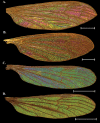
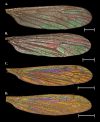
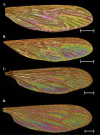
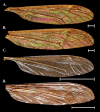
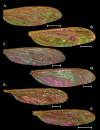
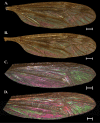
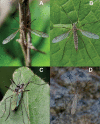
Similar articles
-
The mitochondrial genome of Nephrotoma Tenuipes (Diptera Tipulidae).Mitochondrial DNA B Resour. 2019 Sep 19;4(2):3092-3093. doi: 10.1080/23802359.2019.1667271. Mitochondrial DNA B Resour. 2019. PMID: 33365867 Free PMC article.
-
Characterization of the complete mitochondrial genome of the snow crane-fly Chionea crassipes gracilistyla (Diptera, Tipuloidea, Limoniidae) with phylogenetic analysis.Mitochondrial DNA B Resour. 2019 Jul 22;4(2):2662-2663. doi: 10.1080/23802359.2019.1643796. Mitochondrial DNA B Resour. 2019. PMID: 33365672 Free PMC article.
-
New records for the Western Balkans cranefly fauna (Diptera, Tipuloidea) with the description of a new Baeoura Alexander (Diptera, Limoniidae).Zookeys. 2023 Mar 31;1157:1-42. doi: 10.3897/zookeys.1157.98997. eCollection 2023. Zookeys. 2023. PMID: 37215165 Free PMC article.
-
The mitochondrial genome of Epiphragma (Epiphragma) mediale (Diptera: Limoniidae).Mitochondrial DNA B Resour. 2021 Mar 31;6(4):1321-1323. doi: 10.1080/23802359.2021.1907808. Mitochondrial DNA B Resour. 2021. PMID: 33855189 Free PMC article.
-
Records of Limoniidae and Pediciidae (Diptera) from Armenia, with the first Armenian checklist of these families.Zookeys. 2016 Apr 27;(585):125-42. doi: 10.3897/zookeys.585.8330. eCollection 2016. Zookeys. 2016. PMID: 27199605 Free PMC article. Review.
References
-
- Adler PH, Adler CRL. (1991) Mating behaviour and the evolutionary significance of mate guarding in three species of crane flies (Diptera: Tipulidae). Journal of Insect Behaviour 4: 619–632. 10.1007/BF01048074 - DOI
-
- Ala-Honkola O, Manier MK. (2016) Multiple mechanisms of cryptic female choice act on intraspecific male variation in Drosophilasimulans. Behavior and Ecological Sociobiology, 70: 519–532. 10.1007/s00265-016-2069-3 - DOI
-
- Alexander CP. (1920) The crane-flies of New York. Pt. 2. Biology and phylogeny. Cornell University Agricultural Experimental Station Memoir 38: 691–1133. 10.5962/bhl.title.33641 - DOI
-
- Baxter CV, Fausch KD, Saunders CW. (2005) Tangled webs: Reciprocal flows of invertebrate prey link streams and riparian zones. Freshwater Biology 50: 201–220. 10.1111/j.1365-2427.2004.01328.x - DOI
LinkOut - more resources
Full Text Sources
